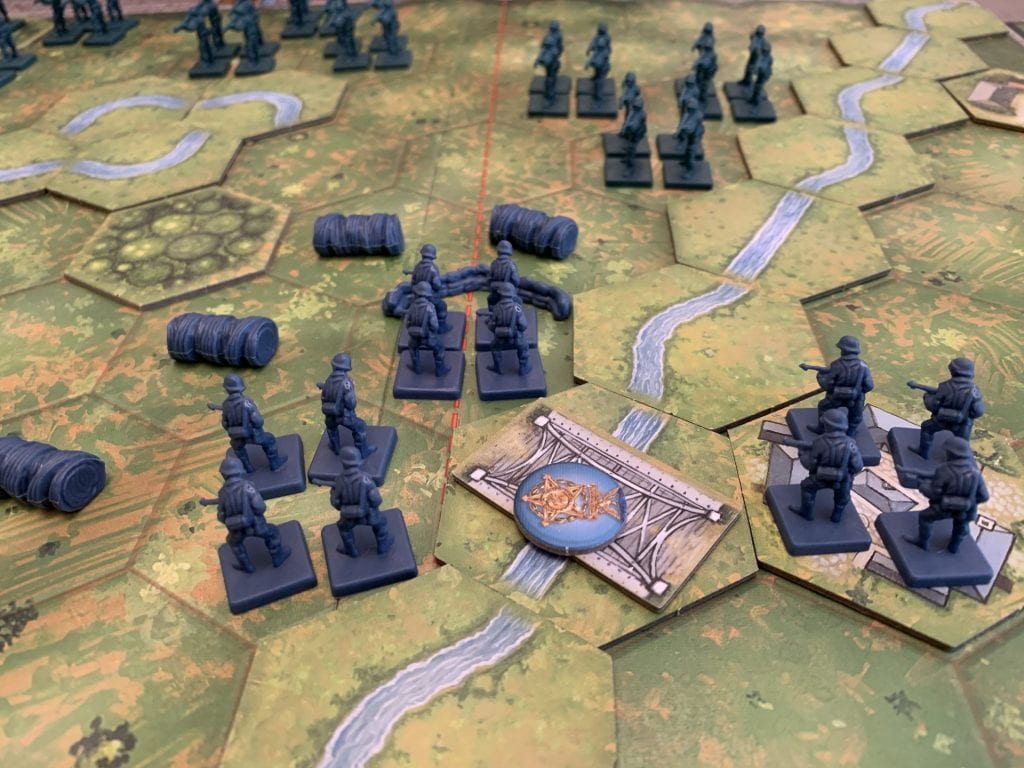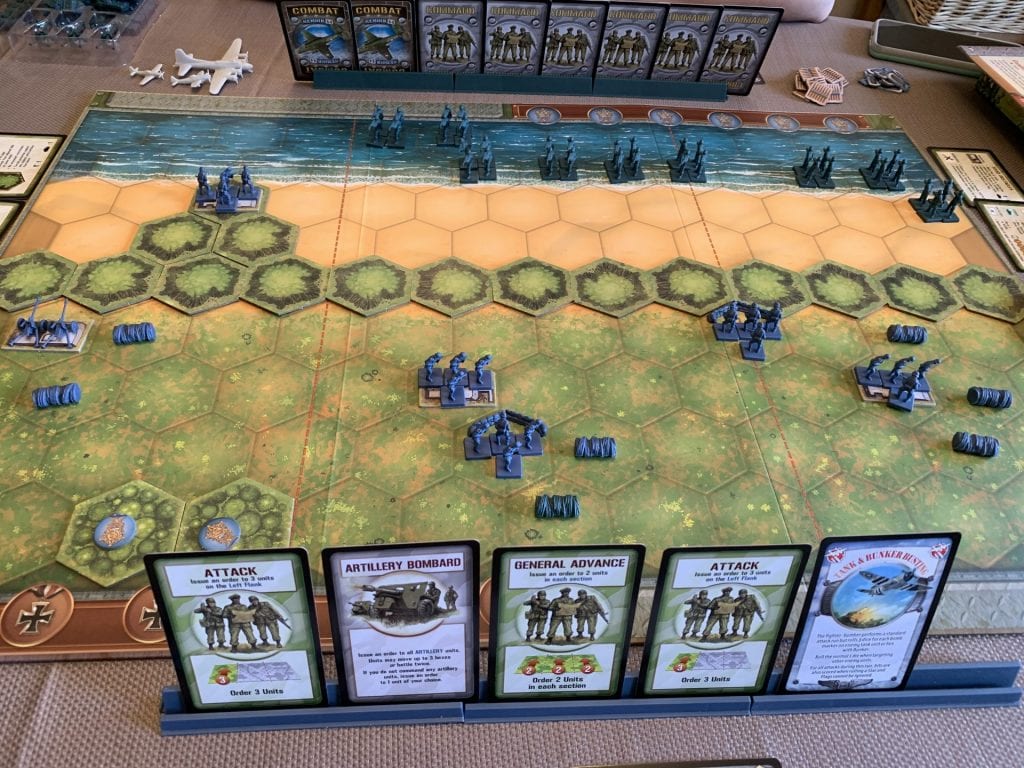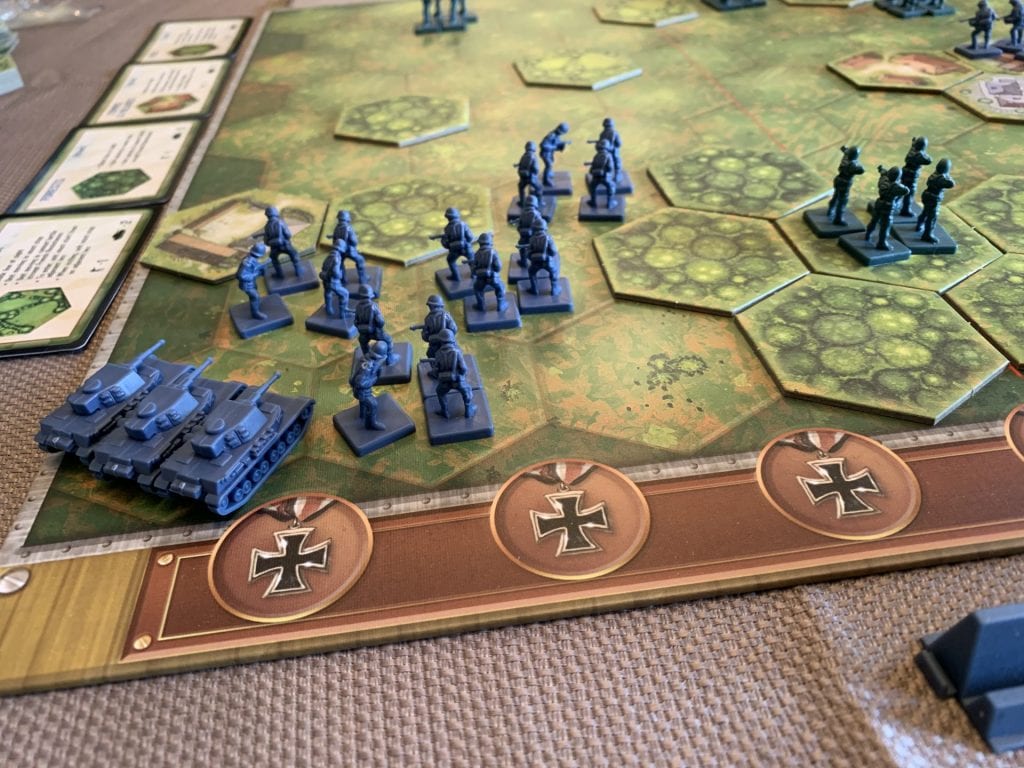Disclosure: Meeple Mountain received a free copy of this product in exchange for an honest, unbiased review. This review is not intended to be an endorsement.
When it comes to wargames, there are tons of factors that help place a game amongst its competition. It can certainly be hard for boardgamers to get into wargaming. What is the scale? What do units represent? Is this aiming to be a simulation, a war-themed game? What about the complexity, the amount of ‘chrome’ that adds minutia to increase the perceived realism of a game’s approach to a certain conflict? Some games revel in their complexity, others try their hardest to remove obstacles while retaining a feeling of authenticity. And then there’s Memoir ’44.
Memoir ’44, to me, feels like it shouldn’t work as a conflict simulation. The scale varies from scenario to scenario. At one time it encompassed the entirety of Omaha Beach, another the glider troop action at Pegasus Bridge, and another the Liberation of Paris. Its units, represented by figures of infantry, tanks, or artillery, can represent squads of commandos, companies of infantry, and every kind of tracked vehicle on the western front. It’s a simple game with simple mechanics, but it somehow manages to convey some of the most important aspects of 20th century warfare in 20-40 minute intervals. There is certainly a (massive) level of abstraction present in any scenario in Memoir ’44 but play encourages a level of tactics that it almost shouldn’t be able to pull off. So how does it do it?
How to Play Memoir ‘44
Games of Memoir ’44 are scenario based. Players pick a historical battle and set up according to a layout provided. This includes placing terrain tiles on the empty hexagonal game board to form cities, forests, cliffs, rivers, and other scenario specific obstacles. Then both sides’ forces are placed according to the scenario, including fortifications, sandbags, and wire. Players draw a hand of command cards that varies by scenario to represent command and control issues. Pegasus Bridge, for example, starts the Axis player with only two cards versus the Allied five, representing their initial surprise at the landings.
On a player’s turn, they must play a command card. These cards are the heart of Memoir ’44 and the wider Commands and Colours system that designer Richard Borg started back in 1999 with Avalon Hill’s Battlecry. Most cards indicate a sector of the battlefield, either the left flank, the center, or the right flank, and a number of units to activate. When played, players can choose that number of units in that particular sector to act, moving and attacking if able. Then a new command card is drawn and play passes to the opponent. It’s such a mechanically simple system, but it opens up so much in terms of good play.

There is little analysis paralysis as there are at most five or six cards to choose from, but the decision of when and where to move units can be very important. Pushing a flank that looks weak might be key to taking an objective, but what about the center, where troops are exposed to enemy fire? The tug of multiple key points on the battlefield makes for interesting decision making and, to a degree, simulates the issues commanders faced when trying to order their men around in the din of battle. Sometimes players will be left with a hand of poor cards, and that is just something a commander would have to deal with. As a simple method of adding an interesting layer of tactical depth to the game, Memoir ‘44’s cards are amazing.
When it comes to doing battle, activated units roll dice to fire at enemies. The number of dice available to each unit depends on their type, their distance to an enemy, and terrain. An infantry unit firing at an enemy two hexes away in woods, for example, would roll one die. Two for a unit two hexes away, minus one for the cover of the woods. Dice are six sided but replace numbers with icons of tanks, infantry, grenades, flags, and a US military star. Depending on the type of unit being attacked, different symbols will do different types of damage. Tanks will only affect tanks, for example. The flag symbols cause a retreat, and grenades hit anything. It makes for a simple and effective system with no math.
To make things even easier, all the specific information about how infantry, tanks, and artillery function are provided on handy cards to be kept near the table. There are also cards for terrain and fortifications, meaning that almost every specific rule that might require referencing is right at hand.
Is this really a wargame?
Well, yes. But it isn’t a simulation. While Memoir ’44 has an interesting and innovative system of command and control in the cards, and does emphasize the importance of terrain and positioning in battle, this is (by design) a stylized game about war. The battles being refought in each scenario are real, but there is such a level of abstraction, both to keep the breadth of the game alive, and as a means of keeping Memoir ’44 playable and interesting for both adults and children, that a lot of the possible accuracy is sacrificed. I believe there is nothing wrong with this. Memoir ’44 is immediately understandable and playable without any deep dive into infantry company tactics or the correct application of battalion artillery. That it manages to make an entertaining and simple game while subtly working in command and control issues and opening players eyes to some history is a bonus. That Memoir ‘44 can achieve such interesting depth of play in such a simple format is key to its longevity and to its value on any gaming table. Non-wargamers will have just as much fun with it as a test of tactical skill as the hardest of hardcore. Because of that I believe it makes for a near perfect entry level wargame.
Memoir ’44 offers 17 historical scenarios in the base game, and each of them offer something interesting. From the airborne invasions of D-Day, one scenario including the dropping of actual figures from 12 inches above the board to see where units land, to underrepresented battles like the liberation of southern France, there is joy in playing through each scenario, both because they are mechanically different and that they may pique interest in learning about a historical engagement that may not be as popular.
Though the core game is quite simple, there are little things added here and there to change up the core formula. Special forces are represented by placing a token next to a unit, and these add extra abilities like moving two hexes and retaining the ability to fire. There are also many expansions for Memoir ’44 that add new armies, terrain, equipment, and scenarios. The extra complexity is out there for those interested, but it is safe to say that the core game of Memoir ’44 is well worth the investment.
Miniatures!? In my Board Wargame!?
Memoir ’44 looks great. The board itself is bright and clear, and the terrain hexes are immediately recognizable. The units, different sculpts for both Allied and Axis figures, are well detailed and sizable. A full game in progress on the board is lively, with miniature tanks almost overflowing from their hexagon, while infantry crowd into a bunker or else spread out to occupy their hex as players wish. It is all very dynamic and three dimensional. The rulebook is clearly laid out with many pictures and examples of play, and scenarios are clear and easy to set up. It’s simply a joy to behold a game of Memoir, and if pushing around little tanks doesn’t immediately appeal then, well, I encourage giving it a go. Explosion noises are optional but encouraged.
Pitfalls and Pathfinding
Memoir ’44 has been around since 2004 and it is very clear that it deserves the praise it gets. I keep repeating that the core system is simple, and I do not mean that in a negative way. Memoir ‘44’s ability to keep that simplicity while bringing engaging scenario after engaging scenario to the table is nothing short of amazing. The core concept of battlefield sectors and card-based activation is just such an excellent idea that the tight rules and sporadic chrome of Memoir ’44 shines all the brighter. But it isn’t perfect.
As I’ve mentioned, this isn’t a simulation, but a stylized representation of a terrible point in human history. The game is very clean though, so some further research and reading is always encouraged, especially when introducing children to the game. Second, the number of expansions that rely on owning other expansions makes moving beyond the initial core box a difficult prospect. Interested buyers must be sure of what they’re getting in each expansion and that they will be happy with the contents of each box. The New Flight Plan expansion, for example, is full of scenarios that are dependent upon owning other expansions. Finally, it must be noted that the core system that I love so much, the card activation and battlefield sector gameplay is part of a wide series of wargames from a multitude of publishers. Commands and Colours is the general name and different games in the series have different complexities and styles. Some use wooden blocks, for example. All versions that I have played are fun.
Memoir ‘44 will be given a permanent place on my shelf. There is a lot of well produced content in the box, and the scenarios, especially if played twice switching sides, will keep most players happy for a long time. It’s an excellent system, well realized in this package, and worthy of the praise it keeps getting.
















Add Comment